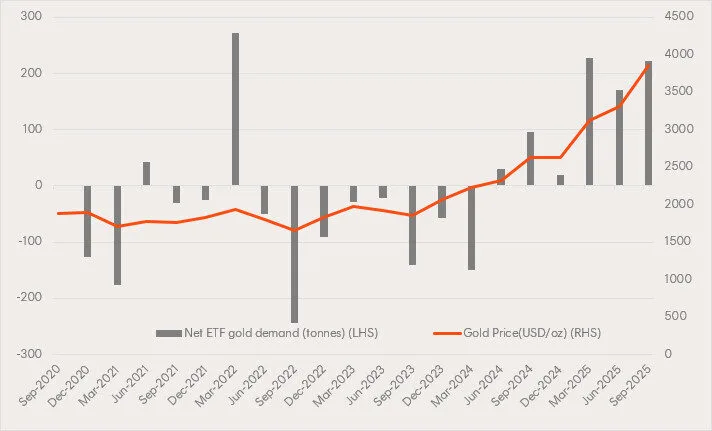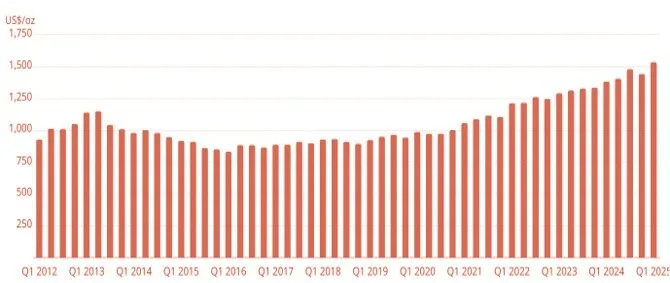Three ways to add gold exposure to your portfolio
Gold hit US$4,000 an ounce for the first time last week and has enjoyed a stunning run since Trump came to power. Yet the rally could be far from over, Goldman Sachs has upgraded their forecast to US$4,900 an ounce, citing strong investor demand and continued central bank buying.
Understanding the role gold can play in portfolios requires a grasp of the key market drivers – who buys gold and why? While jewellery fabrication and industrial use account for approximately 40% of total gold demand1, the main catalyst behind major price movements is gold’s use as a financial asset. Investor and central bank flows together make up around 60% of demand, and have historically had a far greater influence on gold prices than consumers or industrial usage.
We have previously highlighted the ongoing structural support from central banks seeking to diversify their reserves, particularly those from emerging market and non-US aligned countries. The additional catalyst in 2025 has been renewed gold ETF buying. You no longer have to line up at the Perth Mint or Australian Bullion Company to buy gold.
1. Gold Bullion ETFs: Direct Exposure
For investors seeking the most direct exposure to the gold price, bullion-backed ETFs provide an efficient, low-cost, and liquid vehicle. These funds are backed by physical gold bars stored in secure vaults and track the spot price of gold, minus fees.
This year global investors have been allocating to gold bullion ETFs as a portfolio hedge against geopolitical tensions and USD weakness on concerns about US government debt and Federal Reserve independence.
Global Gold ETF Quarterly Net Inflows versus USD Gold Price: September 2020 – September 2025

Source: Bloomberg, World Gold Council, as at 10 October 2025. Gold price returns shown do not account for any fund management fees and costs. Past performance is not an indicator of future performance.
Yet after years of outflows the total amount of gold held by these ETFs is still below its previous peak, and investors arguably remain underweight. So far gold has been the enduring “Trump Trade”, and we expect these inflows to continue.
2. Global Gold Miners: Leverage to the metal and strong margins
Beyond owning gold itself, listed global gold mining companies provide leveraged exposure to the gold price, as revenues rise (or fall) with the price of gold, while their cost base remains relatively static.
Even without a further rally in the gold price, many miners are currently generating strong free cash flows. The “All-In Sustaining Cost” (AISC) in gold mining is a standardised measure that calculates the total recurring cost of producing an ounce of gold, including not just direct mining and processing costs, but equipment costs, royalties, taxes and other overheads needed to maintain ongoing operations. As at the start of 2025, the average AISC of producing gold globally remains around US$1,500 per ounce, well below the current spot price.
All-In Sustaining Cost of gold mining – global average over time

Source: World Gold Council, 2012 – 2025.
This wide production margin is translating into improved profitability, stronger balance sheets, and healthier dividends across the sector. In fact, our Global Gold Miners Currency Hedged ETF (ASX: MNRS) has been the best performing ETF on the ASX for the 12 months to 30 September 2025 returning 105.3%, and 15.24%p.a. over the prior five years.
Unlike buying gold bullion, investing in gold miners allows for potential upside even if gold prices don’t rise further.
3. Gold royalty companies: Exposure without the operational risk
For those seeking exposure to the gold price with lower operational risk, royalty and streaming companies offer a unique alternative. These businesses—such as Franco-Nevada, Wheaton Precious Metals, and Royal Gold—finance mining projects in exchange for a percentage of future production or revenue.
Unlike traditional miners, royalty companies do not operate mines or bear the associated costs of labour, energy or capital expenditure. This structure allows them to maintain high margins and stable cash flow, even when industry costs rise. Moreover, because they collect royalties based on production or sales, their earnings have tended to benefit directly from higher gold prices without the same exposure to operational disruptions or the risk to shareholder value from late cycle gold miner M&A activity.
The royalty model has proven resilient across market environments, with royalty firms often outperforming miners during periods of cost inflation or when gold prices stabilise after a strong run. For example, Franco Nevada has increased its dividends every single year since 2008.
Betashares ETFs: Three pathways to Gold
Betashares offers a range of solutions for investors seeking exposure to gold:
- Gold Bullion Currency Hedged ETF (ASX: QAU) provides a ‘purer’ exposure to the USD gold price, rather than the AUD price of gold, and as such adds value when gold appreciates on USD weakness. QAU has received strong inflows this year and now has $1.35 billion assets under management2.
- Global Gold Miners Currency Hedged ETF (ASX: MNRS) offers exposure to a diversified portfolio of leading global gold mining companies, benefiting from the industry’s strong cash flows and leverage to the gold price.
- Global Royalties ETF (ASX: ROYL) provides access to a diversified portfolio of global royalty and streaming companies with attractive monthly income distributions. Gold royalties companies make up ~37% of the portfolio3, offering gold-linked upside with lower operational risk.
Whether investors are seeking portfolio diversification, leverage to the gold price, or exposure to high-margin royalty businesses, Betashares provides a comprehensive suite of options to participate in the enduring appeal of gold.
1 topic
3 stocks mentioned
3 funds mentioned

